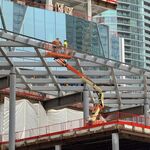Downtown Mississauga? To be a downtown, for me, it should have a intercity and commuter train station, pedestrian traffic, high density, a city hall, office buildings, and good public transit. Mississauga's city hall is next to Square One, but is missing a train station, and is not much in pedestrian traffic. It caters too much to the automobile with all those parking lots.
Downtown Brampton? It has a better features than Mississauga. Though smaller, I think it would be a better downtown designation for the Peel Region than Mississauga. There is a train station, more pedestrian traffic, and if the Hurontario LRT goes through Brampton, better public transit.




